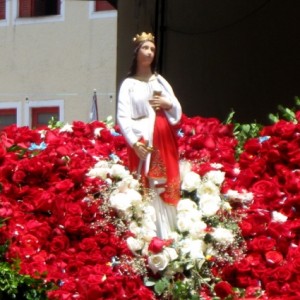
Photo © Michael Sommers.
Last Saturday morning I donned a pair of white shorts, a blood-red t-shirt, white sneakers, and my trusty red Buff bandana (with High UV protection) and made my annual pilgrimage to the Pelourinho, Salvador’s colonial district, for the Festa de Santa Bárbara.
The Festa de Santa Bárbara takes place every December 4 in homage of the patron saint of military engineers, gunsmiths, miners, firefighters and anyone else who traditionally worked with firearms and explosives. Bárbara is who you call upon when you need protection from thunder, lightning, and tempests in general. In Bahia, where the Afro-Brazilian cult of Candomblé reigns strong, the saint has long been associated with the orixá, Iansã, warrior goddess of fire and thunderbolts, whose sacred colors are red and white (which explains my choice of garb).
Unlike some other festas populares, which have begun to lose their traditional flavor and devolve into Carnavalized street parties, Santa Bárbara has remained fairly uncorrupted.It’s said that no matter what the weather (and December in Bahia is inevitably blue-skied and scorchingly sunny), Iansã also makes her presence known on December 4 by sending a few rain clouds and a clap or two of thunder to the proceedings (a seemingly miraculous fact whose truth I can personally attest to). Of course, the thunder is often lost amidst the explosion of fireworks that announce the arrival of dawn and kick off the proceedings, which begin with a sacred mass at the Igreja Nossa Senhora Rosário dos Pretos, a beautiful baroque church with a blue façade that was built as a house of worship by and for African slaves.
The mass is followed by a procession presided over by representatives of both the Catholic church and terreiros de Candomblé in which a host of saints (with Barbara bringing up the rear) are paraded aloft, on lush beds of red and white flowers, while throngs of Bahians, clad in red, follow through the streets. The first stop is at the Palácio dos Bombeiros, a handsome fortress of a place, painted tomato red, that houses Salvador’s main fire station. While the saints enter the Palácio, bombeiros (firemen) bless (and refresh) the crowds with spray from their hoses while fire sirens blare.
Soon after, the saints and throngs continue along their route until they arrive at the Mercado de Santa Bárbara, an old, almost souk-like market dedicated to the patron saint of markets. Here, the effigy of Bárbara is placed in a chapel and, while devotees line up to place red flowers at her feet, the rest of the market explodes with exuberance, inaugurating the profane celebrations that co-exist along with the sacred commemorations in all of Bahia’s festas populares. Beer flows, drums beat, bodies break into spontaneous displays of samba de roda, and people vie for a plate of delicious caruru, the traditional and sacred food made in honor of Iansã (and other orixá).
The Festa de Santa Bárbara is not the most famous of Salvador’s famed festas populares, nor is it the first one I ever experienced, and yet, it is by far my favorite. Unlike some other festas populares, which have begun to lose their traditional flavor and devolve into Carnavalized street parties, Santa Bárbara has remained fairly uncorrupted. The setting – in the narrow cobblestoned streets of the colonial center – is bewitching as are the garments in every possible shade and hue of red worn by all those in attendance that transform the streets into a throbbing sea of red. By far the largest number of Santa Bárbara devotees are women and many create and accessorize their scarlet blouses and crimson dresses in highly original ways that would have even the most cynical, seen-it-all fashionistas’ jaws dropping.
This year was probably the 10th festa that I’ve attended; I realize that it’s become a ritual for me. So much has changed in my life since I first began living in Salvador 12 years ago – but the Festa de Santa Bárbara remains the same, providing continuity, community, and alegria in vivid tones of red. This year I met friends and lost them in the crowd and found them again; we ate and drank and danced, remembered Santa Bárbaras past, flirted with nostalgia, were seduced by the present, and ate and drank and danced some more.